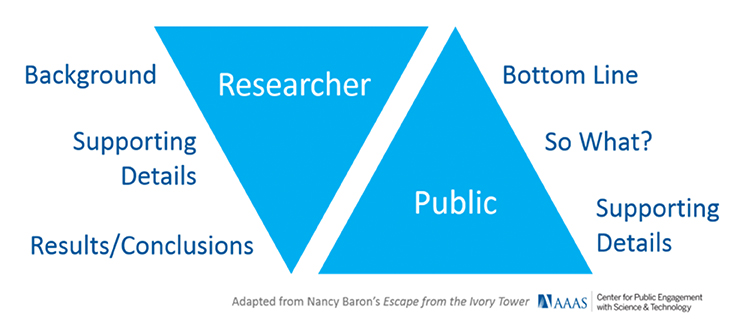Your Message in the Media

You’ve been contacted to talk about your recent publication or to discuss research by another team. Here’s how to prepare.
Working with print, broadcast, and online media reporters requires powerful control of your message – meaning you must plan a clear and focused communication strategy. Don’t trust subject matter knowledge to see you through an interview without preparation.
Plan a SOCO: Single Overriding Communications Objective.
The public health community of the 1970s gets credit for developing the SOCO framework to assure a simple, clear message that is accessible to the public. For instance, in this contemporary example:
Lives will be saved if children and adults who have not been vaccinated get the measles vaccine now to prevent spread. Contact [your county health department] for information about free vaccine times and locations. #VaccinesWork
The goal, target audience, rationale, and actionable information are succinct and pointed. Closer to a tweet than a paragraph. For scientific findings to have traction in the media, researchers typically need to restructure how we conceptualize and present research.
By convention, we build our case from the rationale: starting with background and supporting details followed by methods, results, and conclusions. In contrast, lay audiences respond to the opposite structure. Tell me why I should care (bottom line), what the implications are, and then supporting facts that help me decide whether to trust your information.

Before you go to the studio or pick up the phone for an interview, prepare to write your SOCO.
- What is your objective for doing the interview? Provide meaning and context.
- Who is your most desired audience?
- If you could write the headline or first few sentences of the article, what would it be?
- What three (or fewer) facts would you like the public to remember from your interview?
- What is the take home message or implication?
Though it is fair game and wise to ask in advance what the focus and format of the media segment or written piece will be, and to inquire about audience characteristics, your focus is NOT: “What is the reporter’s or writer’s objective for doing the interview?” While you aim to meet his or her need for information, your objective needs to be YOUR reason for wanting to share information. You want to prepare your SOCO so you can stay on message and deliver the information that has highest value for you and for demonstrating how your science matters.
As a candidate and President, Barack Obama has uncanny ability to stick to a SOCO:
This pattern of looping back and narrowing the focus of conversation to a simple message does not come naturally to most researchers. We prefer and indeed thrive on granularity of detail. To counteract this tendency to cover too much detail or esoteric background, the best advice is to rehearse your SOCO with a colleague, mentor, or member of your institution’s media relations office.
Role play, at minimum, responses to questions like:
- What’s exciting about this discovery?
- What will it mean for people with [some condition]?
- Will this be problematic for [some plausible group/reason]?
- What do you think about [study with contrasting finding]?
After rehearsing write down your final SOCO and keep it with you:
- Meaning and Context: Not more than 3 sentences
- Three Key Facts: Bullets – be brief
- Target Audience: Who does this media outlet reach?
- Communication Objective: Single statement that is easy to say
Don’t skimp on practicing this last item. If your objective is not easy to say, keep revising until you can deliver it smoothly and it sounds fluid and natural. This step makes for a more confident interview and assures you won’t stumble or misstate your main message.
Final pointers:
Always ask what the focus or slant of the article is. Don’t assume the interview is actually about your work. At times your work or expertise is used as entrée to get comment on other science or topics in academics or healthcare. Asking for details in advance helps avoid being taken off guard.
Remember, nothing is off the record, ever. This includes broader discussion in email responses to reporters.
If you find yourself rambling on the phone or in person, stop and say something like “Let me start that again and be more focused.”
If an interview is being videotaped it is fair play to stop and to make a gesture (some use timeout sign) that indicates you are stopping to restate more clearly. Take a moment to regroup and start fresh – wording does not have to match your prior attempt. More than one take is not rare. Using a gesture helps assure that digital editing is not used to retrieve segments you prefer are not used.
Ask in advance if you will be able to see a final draft of written materials. Even if the answer is “no” the reporter will be more aware that you are sensitive to accuracy of the framing of your answers. It is rare to be able to see video footage in advance and common not to see the article, while some will provide outtakes of your quotes as an alternative.
Stay tuned for future posts and we’ll cover how to plan for and increase media coverage of an upcoming publication via your SOCO and use of social media.
RESOURCES
Escape from the Ivory Tower, by Nancy Baron, 2010






1 Comment
Very nicely put, and the sort of thing most folks won’t be familiar with. Is there a similar one for use of Twitter that someone’s written? I’ve got a Twitter account, but essentially never use it.